I like to solve a system of coupled differential equations which involve multiple thresholds. Going through the R information this leads me to using ODE in combination with the root function and the event function.
Going through various examples, i.e. temperature model, page 14 http://cran.r-project.org/web/packages/diffEq/vignettes/ODEinR.pdf -- code pasted below --, I am able to let my model act on one threshold, i.e. finding the root/ reaching the threshold for one variable triggers an event.
library(deSolve)
yini <- c(temp = 18, heating_on=1)
temp <- function(t,y, parms) {
dy1 <- ifelse(y[2] == 1, 1.0, -0.5)
dy2 <- 0
list(c(dy1, dy2))
}
rootfunc <- function(t,y,parms) c(y[1]-18, y[1]-20)
eventfunc <- function(t,y,parms) {
y[1] <- y[1]
y[2] <- ! y[2]
return(y)
}
times <- seq(from=0, to=20, by=0.1)
out <- lsode(times=times, y=yini, func = temp, parms = NULL,
rootfun = rootfunc, events = list(func=eventfunc, root = TRUE))
plot(out, lwd=2)
attributes(out)$troot
The example shows also that different roots can trigger the same event function (y[1] – 18 and y[1]-20 both trigger eventfunc). My question is, however, is it also possible to have different roots trigger different event functions? Said differently, depending on which root is found, a different eventfunc is triggered? Or alternatively, within the same eventfunct, can it do different actions depending on which root is found.
To keep it simple I first wanted to see if this can work using the same example, for instance by naming the roots and by working with an if statement? At the moment that doesn't work. Does anyone have experience with this? If you look at attributes(out) it seems like ODE does keep a record of which root is encountered $indroot (but that's after evaluation.) Thank you in advance.
# library(deSolve)
yini <- c(temp = 18, heating_on=1)
temp <- function(t,y, parms) {
dy1 <- ifelse(y[2] == 1, 1.0, -0.5)
dy2 <- 0
list(c(dy1, dy2))
}
rootfunc <- function(t,y,parms) {
yroot <- vector(len = 2)
yroot[1] <- y[1]-18
yroot[2] <- y[1]-20
return(yroot)
}
eventfunc <- function(t,y, parms) {
y[1] <- y[1]
ifelse(yroot[2]==2, y[2] <- y[2], y[2] <- !y[2])
return(y)
}
times <- seq(from=0, to=20,by=0.1)
out <- lsode(times=times, y=yini, func = temp, parms = NULL,
rootfun = rootfunc, events = list(func=eventfunc, root = TRUE))
plot(out, lwd=2)
attributes(out)$troot
